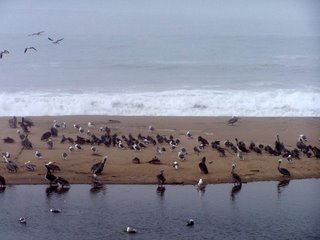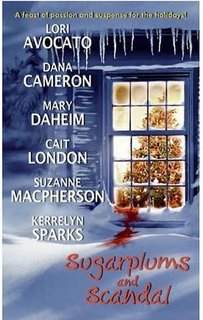
Thursday, September 28, 2006
Thursday, September 21, 2006
How Many Bks at One Time
I'm often asked this question: How many books are your writing now?
I am only able to write one at a time, but there are several others in different processes. At one time, when writing Desires, I could be handling as many as 5 at one time--but only writing one.
The processes could be: 1.) drafting a proposal for a new one; this should be done immediately when finishing one book, waiting for an editorial okay. Or possibly before ending one bk, a writer will keep notes on a new one. 2.) CE or copyedits, which is the original manuscript that has gone through a copy editor for corrections and questions, and then returned to the author. The author then sees if they agree, or possibly adds more to the ms at that time. I may do that on my next set of copyedits as I am now in my second book of a trilogy and have more pinpoints to add to the first book. These additions would be labeled pg. 12a, etc. 3.) Galleys. The step after copyediting, when the pages with all the corrections are typeset into book format, usually left and right page, or perhaps a double space, numbered line set up. The author checks for continuity, spelling, etc. 4.) promotion of a book already published, which is intense in mass market. I calculate that mine consume around a month. 5.) writing a new one.
Juggling time is a major priority with writers and not easy. But I usually call my editors and ask them when I can be seeing the CEs or galleys, or page proofs as they are called sometimes.
This helps me schedule work loads.
I am only able to write one at a time, but there are several others in different processes. At one time, when writing Desires, I could be handling as many as 5 at one time--but only writing one.
The processes could be: 1.) drafting a proposal for a new one; this should be done immediately when finishing one book, waiting for an editorial okay. Or possibly before ending one bk, a writer will keep notes on a new one. 2.) CE or copyedits, which is the original manuscript that has gone through a copy editor for corrections and questions, and then returned to the author. The author then sees if they agree, or possibly adds more to the ms at that time. I may do that on my next set of copyedits as I am now in my second book of a trilogy and have more pinpoints to add to the first book. These additions would be labeled pg. 12a, etc. 3.) Galleys. The step after copyediting, when the pages with all the corrections are typeset into book format, usually left and right page, or perhaps a double space, numbered line set up. The author checks for continuity, spelling, etc. 4.) promotion of a book already published, which is intense in mass market. I calculate that mine consume around a month. 5.) writing a new one.
Juggling time is a major priority with writers and not easy. But I usually call my editors and ask them when I can be seeing the CEs or galleys, or page proofs as they are called sometimes.
This helps me schedule work loads.
Tuesday, September 19, 2006
Using RTF
If you are a PC user, (and I don't know about Apples), you might be interested in writing only in .rft format, which can be saved into almost anything. While working up a synopsis and screen work, I had problems with Word (I use WordPerfect for manuscript work). Then I saved to .rtf, which can be picked up by almost any machine. It worked.
In today's writing world we are going to have to be flexible and use what the computer lords throw at us. For instance, I much preferred my old DOS, function keys for writing than using a mouse. Also, like other writers, I do not like page breaks in draft form. Think of one long roll of paper, per chapter. But for some reason, most software does have page breaks.
In today's writing world we are going to have to be flexible and use what the computer lords throw at us. For instance, I much preferred my old DOS, function keys for writing than using a mouse. Also, like other writers, I do not like page breaks in draft form. Think of one long roll of paper, per chapter. But for some reason, most software does have page breaks.
Keeping the Story Warm
I travel quite a bit and sometimes cannot always log in my few writers hours to keep a story warm. The best thing I've found is to print out the outline and notes and read them as you go--if you can't get to a computer. Of course, those people who are still handwriting, and there are a lot of them, can use their tablets.
Those notes are so important, to keep that story warm inside you and keeping that direction of the story and flow and pulse inside the writing part of you, no matter whatever you are doing.
Once cold, a story is difficult to pickup and run. I'm writing something now that is very fast and a few days away from it was a disaster, so far as momentum.
I am about to step back into the story, this after losing chapter seven, a lead chapter for a suspense. I had to jump into eight and will have to edit when finding seven. this is unusual for me, as I save constantly. But I've been changing machines and things disappear--it was a great active chapter, too. I think I can find it. Maybe.
Those notes are so important, to keep that story warm inside you and keeping that direction of the story and flow and pulse inside the writing part of you, no matter whatever you are doing.
Once cold, a story is difficult to pickup and run. I'm writing something now that is very fast and a few days away from it was a disaster, so far as momentum.
I am about to step back into the story, this after losing chapter seven, a lead chapter for a suspense. I had to jump into eight and will have to edit when finding seven. this is unusual for me, as I save constantly. But I've been changing machines and things disappear--it was a great active chapter, too. I think I can find it. Maybe.
Tuesday, September 12, 2006
Who Owns the Scene
Transitions sometimes take me forever to mull just the right starting place. "Forever" might equal three days or more. For a productive writer who likes writing, that mulling stage seems like a dead end. I think some people might consider that to be Writers Block, but I don't think that way.
I think positive, that this mulling stage is only a nesting time for when just the right idea, or the right scene makes for a good transition in the story line. Frequently, transitions are used to jump the scene ahead to save space. Other transitions can be done with change of POV or with mood.
The next thing is Who Owns the Scene, in whose head are we? That is most important in every scene. Who owns the scene, or is it narration?
To balance this, consider what the scene is and who it most affects? That is who owns the scene. Sometimes just stopping and weighing who owns the scene makes for an easy transition, that is a change of POV.
Take the scene, consider who is most affected by it, which character feels most deeply about it, add a powerful first jump line and you're generally off and running with a transition.
I think positive, that this mulling stage is only a nesting time for when just the right idea, or the right scene makes for a good transition in the story line. Frequently, transitions are used to jump the scene ahead to save space. Other transitions can be done with change of POV or with mood.
The next thing is Who Owns the Scene, in whose head are we? That is most important in every scene. Who owns the scene, or is it narration?
To balance this, consider what the scene is and who it most affects? That is who owns the scene. Sometimes just stopping and weighing who owns the scene makes for an easy transition, that is a change of POV.
Take the scene, consider who is most affected by it, which character feels most deeply about it, add a powerful first jump line and you're generally off and running with a transition.
Wednesday, September 06, 2006
Brand New and Testing

I'm working on this blog while writing a new one, so it will change, esp. the sidebar. Meanwhile, I hope you enjoy it and I'm open to suggestions. And yes, it needs a different banner, something with flash.
CaitLondon.com has been updated with a news and a new contest. (I'm looking for the best reader quote to publish online, complete with initials or full name.)
Here's a preview of a Christmas anthology, SUGARPLUMS AND SCANDAL, short stories shared with Lori Avocato, Dana Cameron, Mary Daheim, Suzanne MacPherson, and Kerrelyn Sparks. I loved stepping in a little of the humor that I'd done while writing Desires.
Subscribe to:
Comments (Atom)
